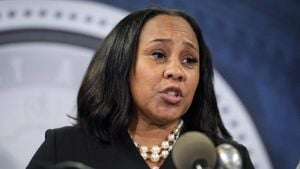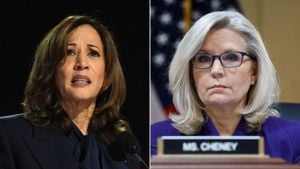With the 2024 U.S. presidential election results rapidly coming to light, the nation finds itself grappling with the repercussions of this contentious and hard-fought battle. President Donald Trump, having once again been summoned to the political spotlight, declared his victory as nothing short of the "greatest political comeback in American history." His supporters echoed this sentiment as they crowded around him, celebrating with fervor at his Mar-a-Lago estate once the results became evident. Meanwhile, Vice President Kamala Harris and her followers processed the shock of their anticipated victory slipping away.
On the election night itself, political commentators tracked the numbers as they rolled in, with states like North Carolina and Ohio falling solidly back in Trump’s favor. Harris struggled significantly, capturing only brief moments of success, such as winning Nebraska's single electoral vote from its 2nd congressional district. Though this marked some progress, it paled compared to Trump's steady lead. Both candidates spent their last hours before the polls closing furiously rallying supporters, with Trump emphasizing his alleged vision to restore greatness, whereas Harris portrayed her campaign as one eligible to unify the divided nation.
Central to this election was not only the clash of candidates but also the shifting sentiment of voters. An exit poll revealed 48% of voters expressing a favorable view of Harris, slightly overshadowing Trump's 44%. Yet, Trump's approval held sway among 51% concerning economic issues, whereas Harris led on the topic of abortion. Such diverging opinions showcased how voters weighed their decisions far beyond mere party lines.
Harris's last-minute pitches targeted states like Pennsylvania, known for its key electoral votes. Her attempts to galvanize the base were based on the potential loss of reproductive rights if Trump regained control. It was apparent through both campaigns' strategies leading up to the election the palpable anxiety surrounding abortion rights and other pressing issues influencing the electorate's choice.
The mood at Trump’s post-election celebration contrasted sharply with the reactions from Harris’ camp. Reports indicate many Harris supporters were left disheartened, and some even broke down crying, caught off guard by the staggering outcome. While Harris opted not to address her supporters after the results became conclusive, Trump basked proudly, promising to unite the nation during his acceptance speech.
Adding layers to the existing tensions was the significant impact of voter demographics revealed by various exit polls. A noteworthy 73% of voters believed democracy itself was under threat, and only 24% felt they were financially more secure than they were four years ago. Such responses highlighted the grim economic realities facing many families, challenging both candidates to rise above mere political banter and address these core issues.
This election drew not only national but also international attention. Leaders across the world, including UK Prime Minister Keir Starmer and Hungary's Viktor Orban, congratulated Trump on his victory, highlighting the sway his presidency holds beyond American borders. On the flip side, liberal commentators anticipated possible scenarios of American decline with Trump's resurgence.
Many claimed the results hinted at fissures within the Democratic voter base, amplifying concerns about the party's direction heading forward. For example, Harris's inability to effectively engage with minority voters compared to Trump, who, according to reports, saw surges in black and Hispanic support, triggered urgent discussions within Democratic circles about strengthening connections with diverse demographics.
Adding fuel to the fire, several Senate races showcased dramatic shifts and surprises. Republicans managed to capture seat after seat, including the upset victory of Bernie Moreno over long-time Democratic Senator Sherrod Brown from Ohio. This defeat not only unseated Brown but dashed Democratic hopes for regaining control of the Senate. With candidates like Deb Fischer narrowly retaining their seats, the GOP appeared to maintain its solid grip over the Senate, leaving the Democrats scrambling for paths to future victories.
Unexpectedly, Missouri turned the tide by overturning its total abortion ban, showing the dual narrative playing out — where one state celebrated reproductive rights as others stood adamant against them. With such contrasting outcomes, the election once again shed light on the country's deep divides and the complex interplay of politics, policy, and people.
Adding to the interesting dynamics was Nebraska's unique delegate allocation process. The state allows for the splitting of electoral votes, which, much to Trump's chagrin, gave Harris's campaign some semblance of foothold with the acquisition of one of Nebraska’s five electoral votes — showcasing how even small victories can bolster campaign morale amid overwhelming outcomes.
Overall, Trump's decisive victory seemed to resonate widely with his base, who felt invigorated by the results. Meanwhile, Harris, once the presumed front-runner, now faces scrutiny and examination from within her party, as questions arise about her campaign’s strategies and her viability for future leadership within the Democratic establishment. Amid the jubilance of Trump’s supporters and the despondence of Harris's, America stands at yet another crossroad, prompted once again to examine the choices made at the ballot.
While the outcomes of various state measures and local races added layers to the national narrative, it was near impossible to ignore the overarching sentiment: this election marked not just another decision at the polls, but also showcased the ever-changing ideals and values of the American populace.



